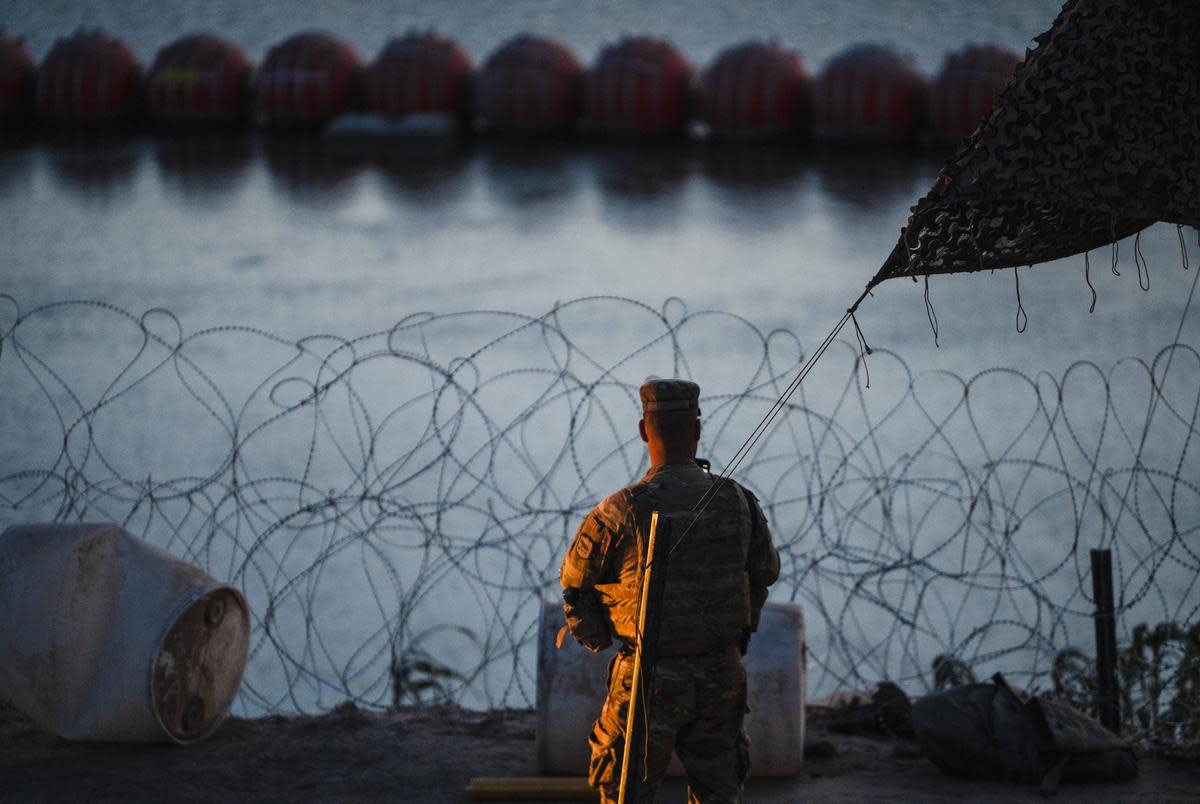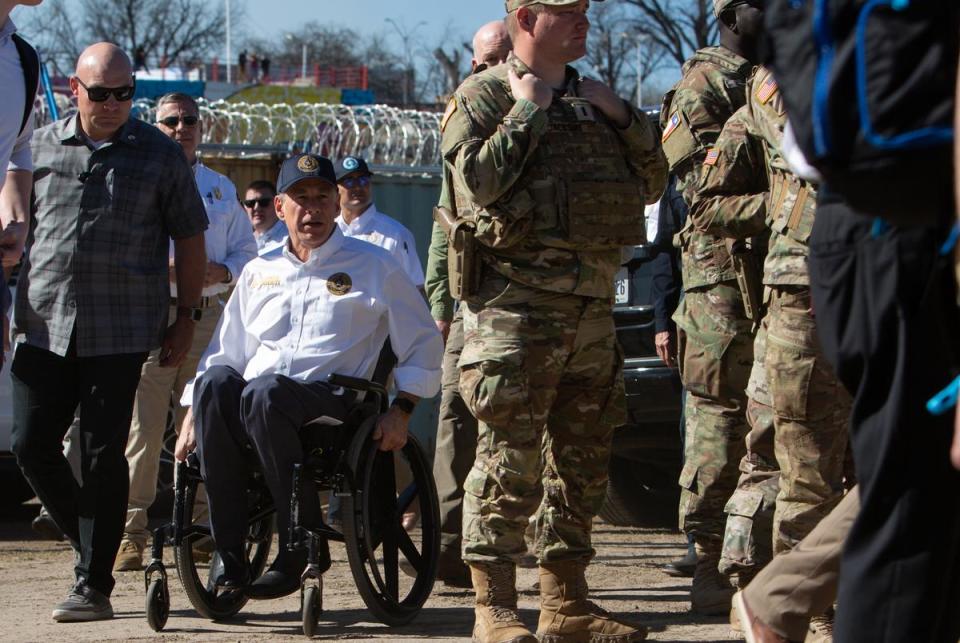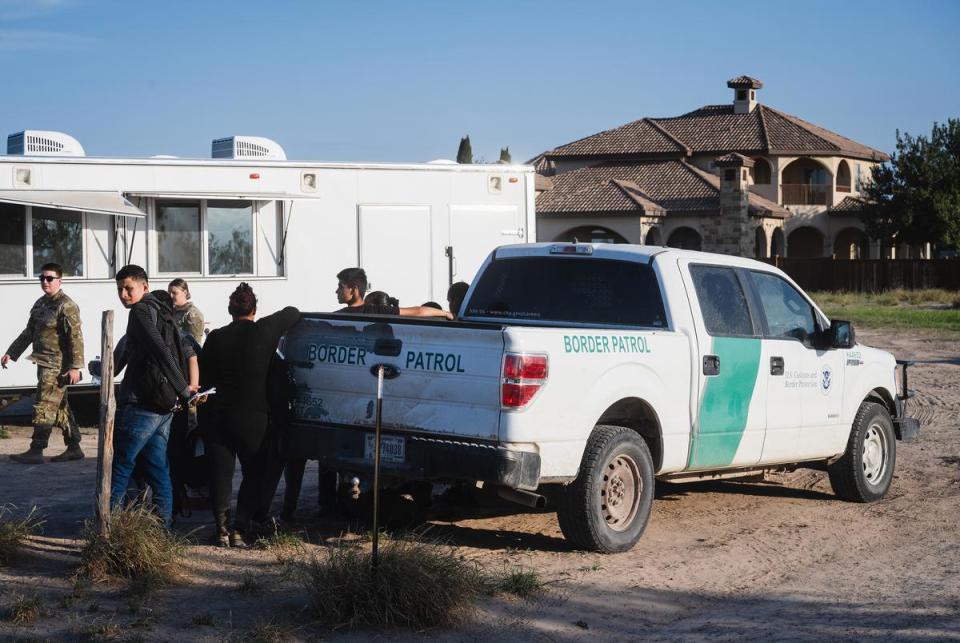GOP-led states have pledged hundreds of troops and spent millions of dollars to help Texas secure the border this year

- Oops!Something went wrong.Please try again later.
This article was reported and written in collaboration with States Newsroom, the nation’s largest state-focused nonprofit news organization, and Stateline, a States Newsroom outlet covering trends in state policy. Read the second part of this report here.
More than a dozen Republican governors gathered in Eagle Pass in February, heeding a call from Texas Gov. Greg Abbott to confront what he labeled "President Joe Biden's border crisis." The governors, along with other GOP state leaders, vowed to send another round of National Guard troops from their states to the Texas-Mexico border.
With shifts in federal pandemic-era border policies, there'd been a sharp increase in migrant encounters in the latter half of 2023. But then January saw a steep, 50% drop.
Still, the governors told their constituents that they needed to send more people to assist Texas in fending off an “invasion,” as both Abbott and Florida Gov. Ron DeSantis have called it, or fight drug smuggling. But the deployments have also been widely criticized as political grandstanding — opportunities to take photos near personnel in uniform on the border while feeding nationalism and fear during an election year.
States Newsroom outlets across the country tracked state deployments and expenses so far this year as part of a collaboration with The Texas Tribune and Stateline to get a sense of what becomes of these promises, how many people were sent to Texas by governors, and at what cost.
DeSantis announced in February he would send 1,050 National Guard troops to assist with Operation Lone Star this year, though it's not yet clear how many have been deployed. In 2024 so far, another 12 states pitched in a total of 921 guard members, plus 37 other law enforcement personnel, and Idaho sent 10 state police officers.
States generally chip in anywhere from five to 200 troops for deployments that can last from a couple of weeks to months. Typically, the funding comes from state budgets or state emergency funds.
South Dakota Gov. Kristi Noem, for example, paid for several National Guard border deployments in recent years with money from the state’s Emergency and Disaster Fund, despite a law that defines emergencies and disasters as events “in any part of the state,” according to South Dakota Searchlight. Yet she declined late last month to deploy National Guard troops to flood-ravaged areas of South Dakota.
Previous border deployments tapped the state’s Emergency and Disaster Fund for at least $1.3 million. Another $1.5 million is budgeted from the fund for this year’s deployment of 60 troops.
States are committing other law enforcement personnel, too. After Idaho Gov. Brad Little sent 10 state police officers in April for a three-week, $205,655 assignment, one ISP trooper said the majority of the time was spent along the border wall assisting the Texas Department of Public Safety and the National Guard with traffic stops and arrests, then turning people over to the Border Patrol.
The states’ contributions are a small part of a massive effort by Abbott to control Texas’ 1,250-mile border with Mexico through Operation Lone Star, launched two months after Biden took office in 2021, at a cost of $11 billion to date.

Abbott has deployed thousands of Department of Public Safety troopers and National Guard members to the border — an unprecedented activation of troops in a state operation — on top of authorizing more border wall construction and using everything from concertina wire to shipping containers to try to block migrants at the Rio Grande.
Soon after the operation began, Texas guard members began to complain about being paid late or not at all, living in cramped mobile homes and a sense of feeling underutilized.
Critics also say the state deployments duplicate effort: The federal government already deploys National Guard members to the border year-round. When the federal government deploys troops for long-term assignments, it gives them much more notice than Texas does.
But the head of the National Guard recently told Congress that these border missions don’t help guard members prepare for their intended mission of defending the nation from a military attack.
Gen. Daniel Hokanson, the chief of the U.S. National Guard Bureau who will retire Sept. 1, told the Senate Appropriations Subcommittee on Defense in mid-June that nearly 2,500 troops were serving at the southwest border under federal command. Sen. Jon Tester, a Democrat from Montana, asked the general about the impact of this deployment on the guard’s other duties.
“There is no military training value for what we do [on the border],” Hokanson said. “For our guardsmen there, they might as well be deployed to Kuwait or somewhere overseas, because they’re away from their families. They’re there doing mission sets that are not directly applicable to their military skill set. That time, I think, would be better utilized building readiness to deter our adversaries.”
When Indiana sent 50 National Guard troops for a 10-month deployment that’s expected to cost $7 million, Gov. Eric Holcomb said the experience would benefit them, according to the Indiana Capital Chronicle.
“I’m reassured that the training that they got before they deployed and assumed this active duty on the southern border was beneficial,” Holcomb told reporters in April not long after an Indiana National Guard member assigned to Operation Lone Star shot a migrant who, according to a Border Patrol bulletin, was attacking another migrant. Texas officials announced they were investigating the shooting.
National Guard members have also begun using pepper ball guns, firing at migrants — including children — on both sides of the border as part of Operation Lone Star, according to The Texas Tribune.
When Missouri Gov. Mike Parson announced he was sending 200 National Guard troops and 22 State Highway Patrol officers to Texas in February, there was some debate over the deployment, which was funded in part by a special appropriation bill. During a budget hearing that month, lawmakers also raised concerns about the highway patrol’s capacity, according to the Missouri Independent.
“Does that not put Missouri at risk when we’re sending even more troopers away when we already have a deficit of 132?” asked state Rep. Deb Lavender, a Democrat from Manchester.
Col. Eric Olson, superintendent of the patrol, said volunteers were selected from eight of the patrol’s nine regions. “Geographically, we spread that out,” Olson said, “and we feel like we will be able to manage this event as well as take care of our duties here at home.”In neighboring Kansas, the legislature this year allocated $15.7 million to send state troops to Texas. But Democratic Gov. Laura Kelly vetoed the funding, reminding lawmakers that she’s the commander-in-chief of the Kansas National Guard — not state legislators.Her veto was overridden by GOP supermajorities in both the House and Senate, and the funding remains in place through fiscal year 2025 but is unlikely to be spent while Kelly remains in office.

Regardless, there are Kansas National Guard troops at the U.S. border as part of federal security efforts funded by the U.S. Department of Defense. Kelly aimed her remarks at Washington, D.C., where Republican senators blocked a sweeping, bipartisan immigration reform measure earlier this year.
“Lawmakers in Washington must act to solve this issue,” Kelly said.
Seth Tupper, Rudi Keller, Sherman Smith, Mia Maldonado, Niki Kelly and Alejandro Serrano contributed to this report.
Big news: director and screenwriter Richard Linklater; NPR President and CEO Katherine Maher; U.S. Rep. Pete Aguilar, D-California; and Luci Baines Johnson will take the stage at The Texas Tribune Festival, Sept. 5–7 in downtown Austin. Buy tickets today!

